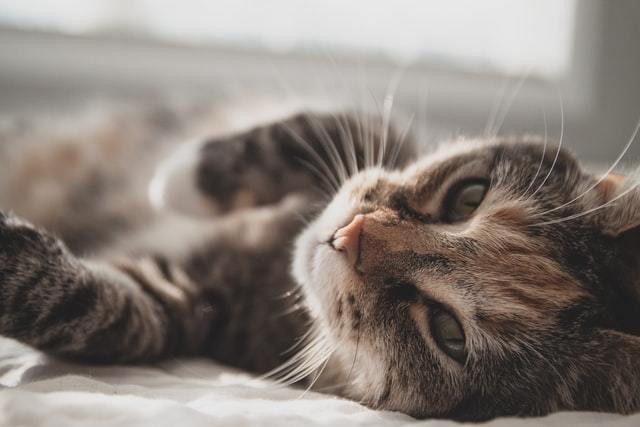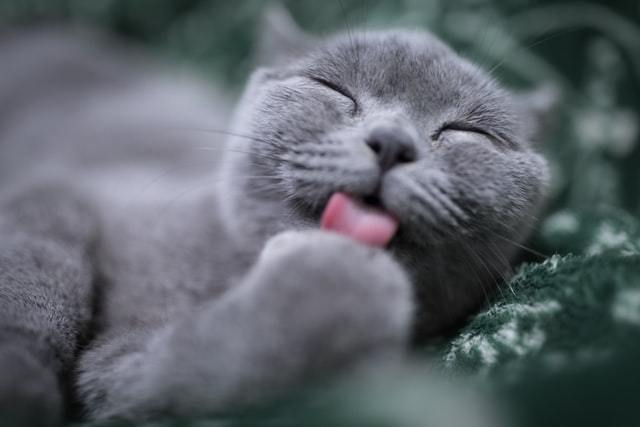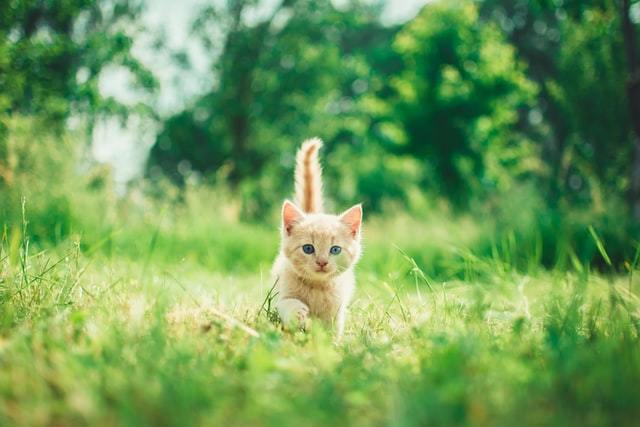Until quite recently, joint problems were not frequently diagnosed or treated in cats. The generally accepted wisdom was that cats just didn’t have many problems with arthritis and other joint conditions.
We now know this is not the case at all. In fact, recent studies suggest that the vast majority of adult cats have joint problems in one or more limbs. How did we human-types get it so wrong for so long?
The reason (probably not all that surprisingly for anyone who knows how cats tick) is that cats are sneaky. Unlike most mammals, cats instinctively hide pain and will do everything in their power to lead a normal life despite being in pain.
While this is an awesome survival mechanism, it means that we have an uphill battle in identifying when a cat has joint problems. But fear not, because in this guide I’m going to give you six ways to tell if your sneaky feline is dealing with joint pain.

GRUMPINESS AND SOCIAL WITHDRAWAL
If your cat has a serious case of the grumpy gertrudes (to use the medical term) take this as your cat telling you it’s time to pay close attention for other signs of pain. Unprovoked growling, hissing or biting, are all potential signs of generalized pain.
If this “back off” behavior is combined with your cat becoming more socially withdrawn, you’re definitely dealing with a big red flag.

CHANGED EATING AND BATHROOM HABITS
It’s also a big “uh-oh moment” when a cat starts eating, drinking or doing its business in different parts of the house.
Cats are very particular about their … ahem … personal hygiene habits. If they suddenly begin to abandon their litter box in favor of easier locations, it may be that sore joints are to blame.

LESS MOVEMENT
Our domestic cat buddies are basically tigers trapped in much smaller bodies. Hunting and roaming are as natural to cats as drinking coffee and complaining about the weather are to humans.
If your cat begins to move less and is no longer interested in chasing a favorite fluffy toy or roaming its territory, this is almost certainly because joint pain is raining on their parade.

NEW SLEEPING PATTERNS
Sleep is the body’s way of going into “healing mode.” This is as true of Felis Domesticus as it is of Homo Sapiens. If your furry companion is catching 💤 a lot more than normal, they may be dealing with joint pain.
Pay attention to where a cat sleeps, too. If they begin to sleep in low, hidden and easy-to-access places it’s probably because it hurts too much to get to their usual perch.

POOR GROOMING
A cat’s coat is the window to its soul. If a cat’s fur becomes matted, scruffy or dull I’ll bet my entire collection of Star Wars action figures that this is a cat that is in discomfort.
You may also notice “focused grooming.” A cat tends to groom where it hurts. If you see your cat spending a lot of time cleaning one area, there’s a good chance they’re aware that something is wrong and they’re trying to lick away the pain.

LIMPING OR FAVORING A LIMB
Now, it’s stating the obvious to say that if one of your cat’s limbs are in pain, you’ll see limping or favoring while the cat is in motion.
There’s an important caveat here though. Remember how cats hide pain because they’re so flingin’ flangin’ sneaky? Yep, that. Cats will try their hardest not to limp so any kind of changed motion will be very subtle.
You’re going to have to be observant for this one. Here’s a tip though. Watch a cat first thing in the morning. If there’s any joint pain or stiffness it’s typically most pronounced in the morning.
Cats are sneaky, but if you’re observant you will see the signs of joint pain. I have one last piece of advice, and in ways it might be the most important tool in your arsenal: trust your gut.
Let’s face it. We cat-lovers spend half our lives learning how our cat thinks. We become experts at reading their odd moods and eccentric ways. If you have a feeling or intuition your cat is in pain, there’s a good chance you’re right.
SO... WHAT CAN YOU DO?
Good question! To start things off, make sure your kitty maintains a healthy weight throughout their life can help to reduce their chances of developing joint problems.
Excess weight can put excess strain on your cat’s joints, even in daily tasks, such as walking or jumping and, though being overweight doesn’t increase your cat’s chances of developing joint problems, it can make existing conditions worse.
Not only that take your cat for regular vet checkups and provide warm, comfortable bedding.
Warmth helps to alleviate the pain of your cat’s joint problems, as it can help to keep them from stiffening up. Also, ensuring they have somewhere comfortable to lay will not only provide them with comfort when they are in pain, it can also help support and take pressure off their joints when they are laying down.
- ONE MORE THING...
If you really want to support your cats joint health, then check out the Scruffy Paws Hip n Joint Vitalize Drops.
They are one of the few joint support supplements that combine 5 of the most effective, scientifically backed joint support ingredients into 1 to offer a FULL SPECTRUM support.
When taken regularly the formulation can help reduce pain, swelling and stiffness. Support joint flexibility and mobility, and maintain healthy cartilage and connective tissue!
Here's what some of our customers have said:
"GREAT DAME STROLLS AGAIN- An eighteen year old with little back leg muscle walked hesitating with each step until she willing lapped up her new med. Today , she walks in the grass , hops from chair to chair and smiles alot"
- Mary G
⭐️⭐️⭐️⭐️⭐️
"LIKE A NEW KITTY - Our cat Pinkie has suffered from hip problems for a couple of years. This product has her acting like a young kitten, very active and playful. Great product!!!"
- David J
⭐️⭐️⭐️⭐️⭐️
"GREAT PRODUCT - My cat is so much more mobile since starting this product! I mix it in with his wet food and he loves the taste!"
- Catherine B
⭐️⭐️⭐️⭐️⭐️
Anywho, thats enough from us today! I hope you found this blog post useful and informative. If you'd like to add a skip to your cats step, check out the Hip n Joint Vitalize Drops here




2 comments
It has stopped my 12 year old cat’s one leg limp that he had for the last five years …no more limp now
Please send me info so I can order another jar of Kidney Vitalize for felines . Thanks